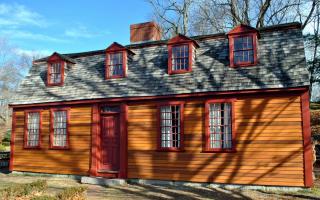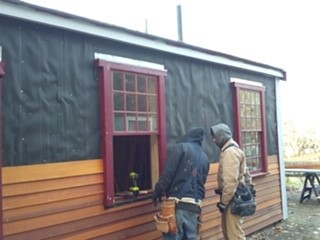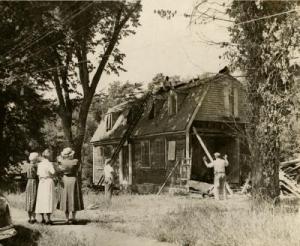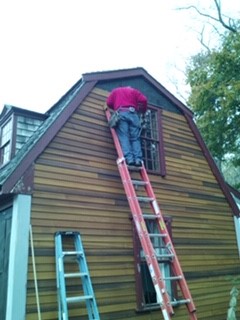Preserving Abigail Adams’s Birthplace: CPA Helps Rescue Weymouth’s “Hidden Gem”

The first lady and wife of the nation’s second president, Abigail Adams was born and raised in a two-story saltbox-style home in North Weymouth. Until recently, the future of this historic site, museum and national treasure was in question due to its diminishing condition.
The 328-year-old house, where the then Abigail Smith was born in 1744, is situated next to the North Weymouth Cemetery about five miles east of Adams National Historical Park in Quincy, which commemorates the birthplace of Presidents John Adams and John Quincy Adams.
 The house last underwent a major renovation in 1947 by the newly-formed Abigail Adams Historical Society. Since then, repair needs ranging from deteriorating sills, siding and windows and problems such as nonexistent heating and cooling systems have accrued. But the Society, a volunteer-driven organization with a small budget and steep insurance costs, has lacked the resources to undertake further substantial restorations.
The house last underwent a major renovation in 1947 by the newly-formed Abigail Adams Historical Society. Since then, repair needs ranging from deteriorating sills, siding and windows and problems such as nonexistent heating and cooling systems have accrued. But the Society, a volunteer-driven organization with a small budget and steep insurance costs, has lacked the resources to undertake further substantial restorations.
However, in 2011, the city found a new source of revenue to address these long-overdue problems. The Weymouth Community Preservation Committee voted to grant $150,000 in total from their CPA Historic Reserve funds to help the Society rejuvenate the home and extend its visitor season through the winter. Previously, the home was forced to close its doors to visitors during cold weather months due to a lack of heating infrastructure.
A historian at Massachusetts Maritime Academy and longtime member of the Weymouth CPC, Christopher Hannan, saw firsthand the Birthplace’s transformation.
“I respect and know how hard the people of Weymouth have worked to save the Birthplace and keep it going,” Hannan said. “It was a struggle. The Historical Society has limited funds. The community preservation grant allowed us to shore up the inside and make it beautiful on the outside.”
 The 1,334-square-foot house was originally constructed in 1685 by the minister of Weymouth’s First Church, Samuel Torrey. Fifty-three years later, Abigail’s father Rev. William Smith bought the home where Abigail lived until, at the age of 20, she married John Adams.
The 1,334-square-foot house was originally constructed in 1685 by the minister of Weymouth’s First Church, Samuel Torrey. Fifty-three years later, Abigail’s father Rev. William Smith bought the home where Abigail lived until, at the age of 20, she married John Adams.
The house was eventually sold back to the church in 1838, and the original structure was transported by oxen from its first location to a farm located on what is now Route 3A. After the U.S. government purchased the land surrounding the new location for the purpose of federal housing in the 1940s, the house – then completely vacated and rundown – was offered to any group willing to take ownership over it. As a result, the Abigail Adams Historical Society was established. The group managed to secure enough resources to move the structure back to a plot within 100 yards of its initial building site.
The recent CPA grant allowed the Society to carry out an assessment followed by extensive work to the exterior and interior of the home in compliance with the Secretary of the Interior’s Standards for treatment of historic properties. The restoration took two years to complete. To learn more about the restored Birthplace, visit the Society's website here and click here to view a slide show and footage of the home’s transformation.
“It was important to us to address problems correctly,” Hannan said, recounting that the blue paint which covered the exterior for decades was not authentic and only served to hide the graffiti sprayed on the house. CPA funds allowed the restoration effort to bring the siding back to its original wood aesthetic.
 Weymouth CPC Chair Walter Flynn, who witnessed the project unfold and attended the Birthplace’s re-opening celebration in July, said the project typifies the potential CPA has to enrich a community.
Weymouth CPC Chair Walter Flynn, who witnessed the project unfold and attended the Birthplace’s re-opening celebration in July, said the project typifies the potential CPA has to enrich a community.
“The opening had an overwhelming response,” said Flynn. “What the project is doing is bringing back to the people of Weymouth and to the students in Weymouth schools the story of Abigail Adams … and her role in the early part of our country’s history.”
The restoration effort also spurred other local individuals and groups to help out with the Birthplace's reopening. A Boy Scout troop of teens from Weymouth, Braintree, and Hanover helped construct a terraced walking staircase in the rear of the building, while Weymouth families and residents worked to landscape the grounds.
Since the reopening, the Historic Society has announced plans to revitalize the Birthplace's museum and educational components with additional resources and programming on Abigail’s life and impact.
“Our hopes going forward are to involve more students in Weymouth,” Hannan said, “so they can know and cherish their own heritage.”
Hannan added that while Abigail will be permanently etched into the history of his hometown, her influence extends abroad and helped first define for Europe what it meant to be an American.
“It was a local board that stepped up and realized that this local project also has national significance and international importance,” Hannan said.
In addition to celebrating the Birthplace's reopening, Weymouth is moving forward with other CPA efforts to preserve the city's history, according to Flynn, who mentioned that just a stone’s throw from the Abigail Adams site lies another CPA project now getting underway.
“Across the road, we’ve begun refurbishing the gravestones of the Smiths, Abigail’s parents,” Flynn said of a new CPA project at the North Weymouth Cemetery.

